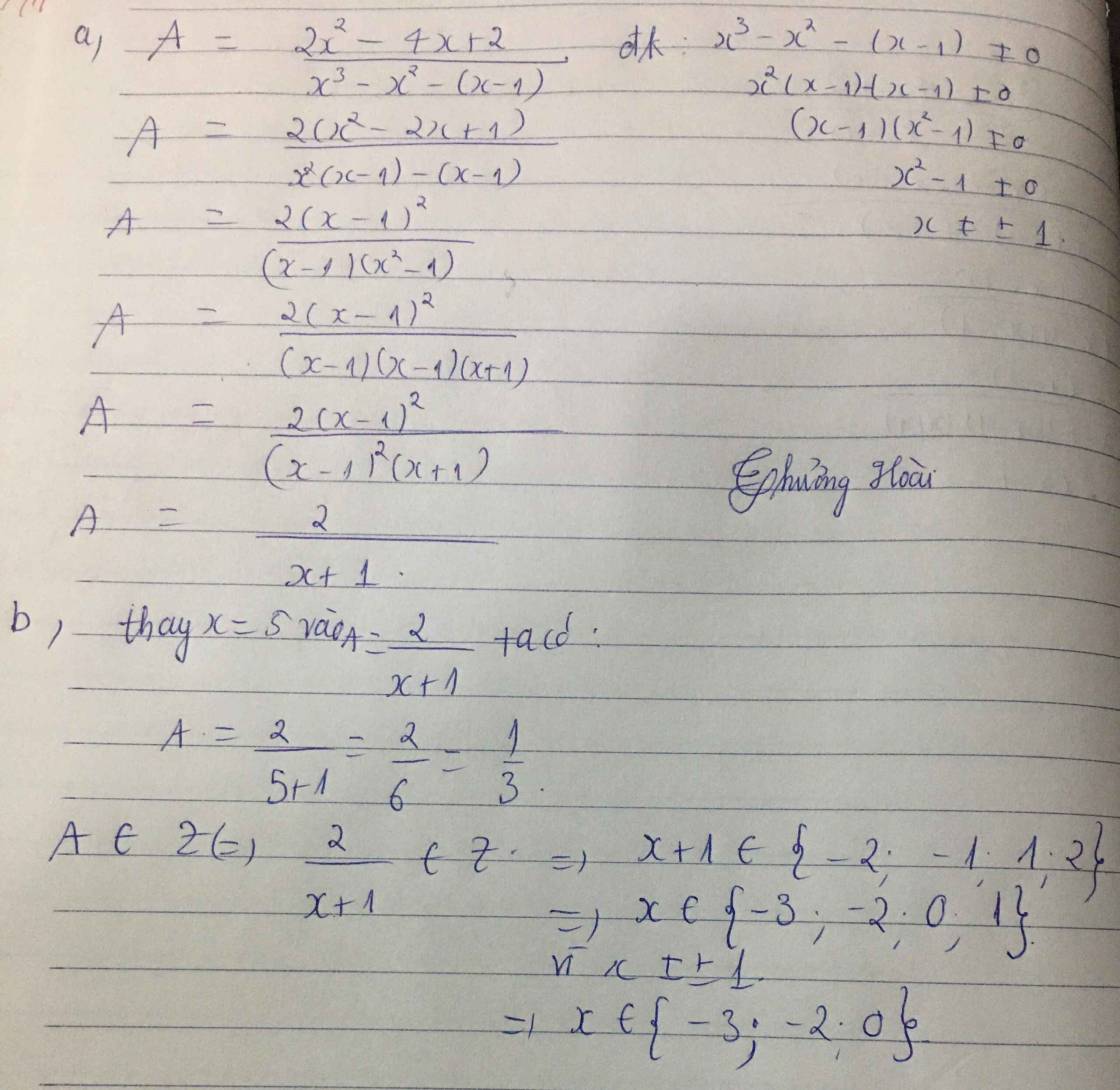Chứng minh A=2x+2/x+3 tìm giá trị nguyên của x để biểu thức trên có giá trị nguyên
Hãy nhập câu hỏi của bạn vào đây, nếu là tài khoản VIP, bạn sẽ được ưu tiên trả lời.


b: Để A là số nguyên thì \(2x+2⋮x+3\)
\(\Leftrightarrow x+3\in\left\{1;-1;2;-2;4;-4\right\}\)
hay \(x\in\left\{-4;-1;-5;1;-7\right\}\)

\(A=\left(2x+1\right)\left(x^2+1\right)+\dfrac{4}{2x+1}\) (chia đa thức)
Để A nguyên \(\Rightarrow4⋮2x+1\Rightarrow\left(2x+1\right)=\left\{-4;-2;-1;1;2;4\right\}\)
\(\Rightarrow x=\left\{-\dfrac{5}{2};-\dfrac{3}{2};-1;0;\dfrac{1}{2};\dfrac{3}{2}\right\}\)
x thỏa mãn đk đề bài là \(x=\left\{-1;0\right\}\)

a: \(A=\dfrac{x^2-2x+2x^2+4x-3x^2-4}{\left(x-2\right)\left(x+2\right)}=\dfrac{2x-4}{\left(x-2\right)\left(x+2\right)}=\dfrac{2}{x+2}\)
a, \(\dfrac{x}{x+2}\) + \(\dfrac{2x}{x-2}\) -\(\dfrac{3x^2-4}{x^2-4}\)
= \(\dfrac{x}{x+2}+\dfrac{2x}{x-2}-\dfrac{3x^2+4}{x^2-4}\)
= \(\dfrac{x}{x+2}+\dfrac{2x}{x-2}-\dfrac{3x^2+4}{\left(x+2\right)\left(x-2\right)}\)
= \(\dfrac{x\left(x-2\right)+2x\left(x+2\right)-3x^2-4}{\left(x+2\right)\left(x-2\right)}\)
= \(\dfrac{2x-4}{\left(x+2\right)\left(x-2\right)}=\dfrac{2\left(x-2\right)}{\left(x+2\right)\left(x-2\right)}=\dfrac{2}{x+2}\)
Có vài bước mình làm tắc á nha :>

\(\frac{2x+3}{x-5}\)\(=\frac{2\left(x-5\right)+13}{x-5}\)
\(=\frac{2\left(x-5\right)}{x-5}+\frac{13}{x-5}\)
\(=2+\frac{13}{x-5}\)
để biểu thức trên có giá trị nguyên <=> \(\frac{13}{x-5}\)thuộc Z
mà \(x\)thuộc Z => \(x-5\)thuộc ước của \(13\)
=> \(x-5\)thuộc \(\left(1;-1;13;-13\right)\)
=>\(x\)thuộc \(\left(6;4;18;-8\right)\)
vậy ....
\(\frac{x^3-2x^2+4}{x-2}\) \(=\frac{x^2\left(x-2\right)+4}{x-2}\)
\(=x^2+\frac{4}{x-2}\)
để biểu thức trên đạt giá trị nguyên <=> \(\frac{4}{x-2}\) thuộc giá trị nguyên
mà \(x\) là số nguyên => \(x-2\)thuộc ước của \(4\)
=> \(x-2\) thuộc \(\left(1;-1;2;-2;4;-4\right)\)
=> \(x\)thuộc \(\left(3;1;4;0;6;-2\right)\)
vậy...

\(\dfrac{2x^3+x^2+2x+2}{2x+1}\left(đk:x\ne-\dfrac{1}{2}\right)=\dfrac{\left(2x+1\right)\left(x^2+1\right)}{2x+1}+\dfrac{1}{2x+1}=x^2+1+\dfrac{1}{2x+1}\)
Do x nguyên nên để biểu thức trên có giá trị nguyên thì :
\(1⋮2x+1\Rightarrow2x+1\inƯ\left(1\right)=\left\{1;-1\right\}\)
\(\Rightarrow x\in\left\{0;-1\right\}\)
\(\dfrac{2x^3+x^2+2x+2}{2x+1}\)
\(=\dfrac{2x^3+x^2+2x+1+1}{2x+1}\)
\(=x^2+1+\dfrac{1}{2x+1}\)
Để đó là số nguyên thì \(1⋮2x+1\)
\(\Leftrightarrow2x+1\in\left\{1;-1\right\}\)
\(\Leftrightarrow2x\in\left\{0;-2\right\}\)
hay \(x\in\left\{0;-1\right\}\)

A = \(\dfrac{2x-1}{x+2}\)
a, A là phân số ⇔ \(x\) + 2 # 0 ⇒ \(x\) # -2
b, Để A là một số nguyên thì 2\(x-1\) ⋮ \(x\) + 2
⇒ 2\(x\) + 4 - 5 ⋮ \(x\) + 2
⇒ 2(\(x\) + 2) - 5 ⋮ \(x\) + 2
⇒ 5 ⋮ \(x\) + 2
⇒ \(x\) + 2 \(\in\) { -5; -1; 1; 5}
⇒ \(x\) \(\in\) { -7; -3; -1; 3}
c, A = \(\dfrac{2x-1}{x+2}\)
A = 2 - \(\dfrac{5}{x+2}\)
Với \(x\) \(\in\) Z và \(x\) < -3 ta có
\(x\) + 2 < - 3 + 2 = -1
⇒ \(\dfrac{5}{x+2}\) > \(\dfrac{5}{-1}\) = -5 ⇒ - \(\dfrac{5}{x+2}\)< 5
⇒ 2 - \(\dfrac{5}{x+2}\) < 2 + 5 = 7 ⇒ A < 7 (1)
Với \(x\) > -3; \(x\) # - 2; \(x\in\) Z ⇒ \(x\) ≥ -1 ⇒ \(x\) + 2 ≥ -1 + 2 = 1
\(\dfrac{5}{x+2}\) > 0 ⇒ - \(\dfrac{5}{x+2}\) < 0 ⇒ 2 - \(\dfrac{5}{x+2}\) < 2 (2)
Với \(x=-3\) ⇒ A = 2 - \(\dfrac{5}{-3+2}\) = 7 (3)
Kết hợp (1); (2) và(3) ta có A(max) = 7 ⇔ \(x\) = -3

a: \(A=\left(\dfrac{x}{x^2-4}+\dfrac{4}{x-2}+\dfrac{1}{x+2}\right):\dfrac{3x+3}{x^2+2x}\)
\(=\dfrac{x+4x+8+x-2}{\left(x-2\right)\left(x+2\right)}\cdot\dfrac{x\left(x+2\right)}{3\left(x+1\right)}\)
\(=\dfrac{6\left(x+1\right)\cdot x\left(x+2\right)}{3\left(x+1\right)\left(x-2\right)\left(x+2\right)}\)
\(=\dfrac{2x}{x-2}\)

a: ĐKXĐ: x<>-1
b: \(P=\left(1-\dfrac{x+1}{x^2-x+1}\right)\cdot\dfrac{x^2-x+1}{x+1}\)
\(=\dfrac{x^2-x+1-x-1}{x^2-x+1}\cdot\dfrac{x^2-x+1}{x+1}=\dfrac{x^2-2x}{x+1}\)
c: P=2
=>x^2-2x=2x+2
=>x^2-4x-2=0
=>\(x=2\pm\sqrt{6}\)

\(A=\dfrac{2x+2}{x+3}.\left(x\ne-3\right).\)
\(A=2+\dfrac{-4}{x+3}.\)
Để \(A\in Z.\Leftrightarrow2+\dfrac{-4}{x+3}\in Z.\Leftrightarrow x+3\inƯ\left(-4\right)=\left\{1;-1;2;-2;4;-4\right\}.\)
\(\Rightarrow x\in\left\{-2;-4;-1;-5;1;-7\right\}.\)